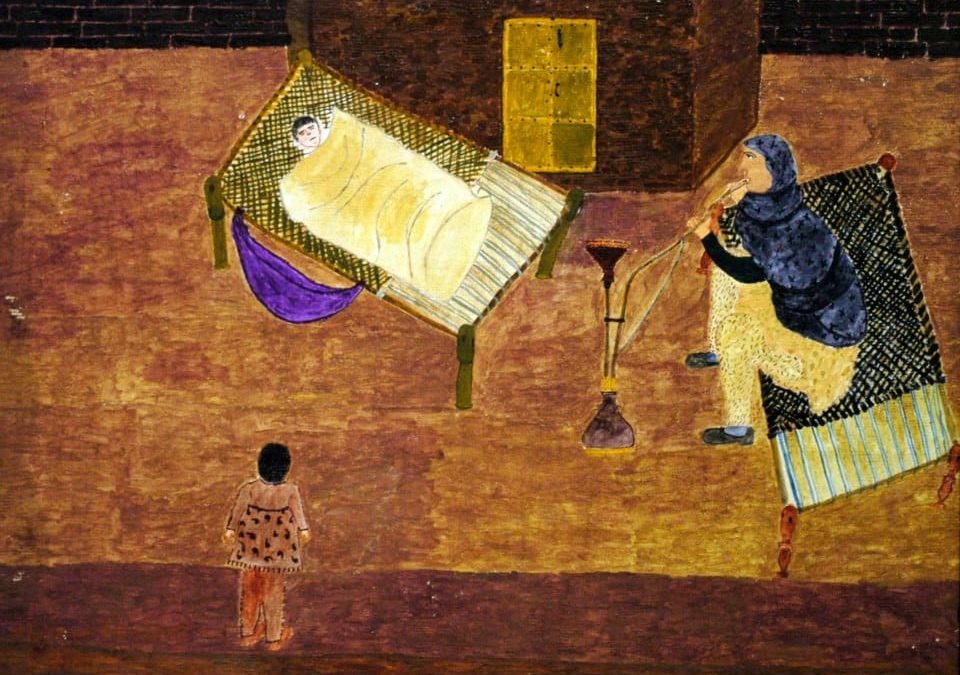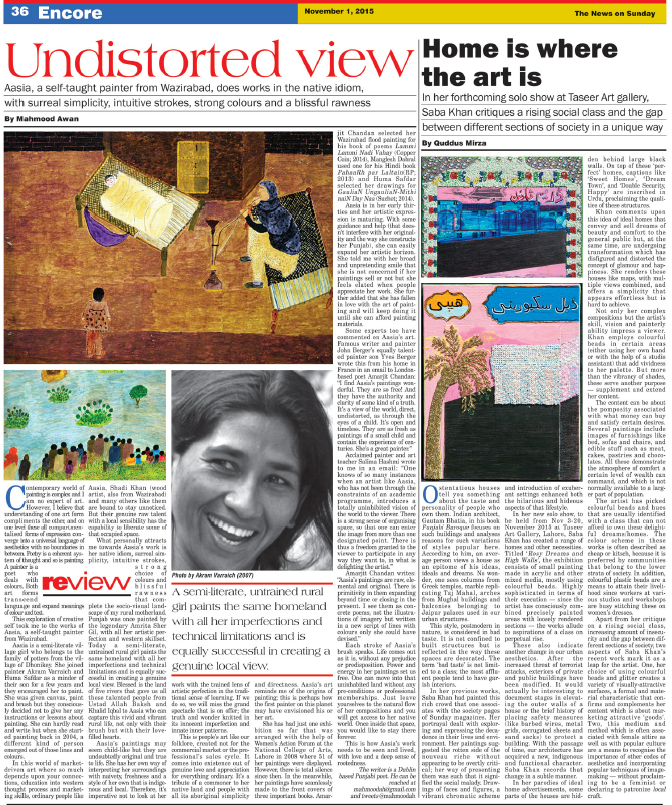Mahmood Awan (The News on Sunday, 1st November 2015)
Contemporary world of painting is complex and I am no expert of art. However, I believe that understanding of one art form compliments the other, and on one level these all compartmentalised forms of expression converge into a universal language of aesthetics with no boundaries in between. Poetry is a coherent system of thought and so is painting. A painter is a poet who deals with colours. Both art forms transcend language and expand meanings of colour and text.
This exploration of creative self took me to the works of Aasia, a self-taught painter from Wazirabad.
Aasia is a semi-literate village girl who belongs to the family of potters from the village of Dhonikey. She joined painter Akram Varraich and Huma Safdar as a minder of their son for a few years and they encouraged her to paint. She was given canvas, paint and brush but they consciously decided not to give her any instructions or lessons about painting. She can hardly read and write but when she started painting back in 2004, a different kind of person emerged out of those lines and colours.
In this world of market-driven art where so much depends upon your connections, education into western thought process and marketing skills, ordinary people like Aasia, Shadi Khan (wood artist, also from Wazirabad) and many others like them are bound to stay unnoticed. But their genuine raw talent with a local sensibility has the capability to liberate some of that occupied space.
What personally attracts me towards Aasia’s work is her native idiom, surreal simplicity, intuitive strokes, strong choice of colours and blissful rawness that complete the socio-visual landscape of my rural motherland. Punjab was once painted by the legendary Amrita Sher Gil, with all her artistic perfection and western skillset. Today a semi-literate, untrained rural girl paints the same homeland with all her imperfections and technical limitations and is equally successful in creating a genuine local view. Blessed is the land of five rivers that gave us all these talented people from Ustad Allah Baksh and Khalid Iqbal to Aasia who can capture this vivid and vibrant rural life, not only with their brush but with their love-filled hearts.
Aasia’s paintings may seem child-like but they are undoubtedly original and true to life. She has her own way of interpreting her surroundings with naivety, freshness and a style of her own that is indigenous and local. Therefore, it’s imperative not to look at her work with the trained lens of artistic perfection in the traditional sense of learning. If we do so, we will miss the grand spectacle that is on offer; the truth and wonder knitted in its innocent imperfection and innate inner patterns.
This is people’s art like our folklore, created not for the commercial market or the professional’s sales cycle. It comes into existence out of genuine love and appreciation for everything ordinary. It’s a tribute of a commoner to her native land and people with all its aboriginal simplicity and directness. Aasia’s art reminds me of the origins of painting; this is perhaps how the first painter on this planet may have envisioned his or her art.
She has had just one exhibition so far that was arranged with the help of Women’s Action Forum at the National College of Arts, Lahore in 2008 where 51 of her paintings were displayed. However, there is total silence since then. In the meanwhile, her paintings have seamlessly made to the front covers of three important books. Amarjit Chandan selected her Wazirabad flood painting for his book of poems Lammi Lammi Nadi Vahay (Copper Coin; 2014), Manglesh Dabral used one for his Hindi book PahaaRh par Laltain(RP; 2013) and Huma Safdar selected her drawings for GauliaN UngauliaN-Mithi naiN Day Naa (Suchet; 2014).
Aasia is in her early thirties and her artistic expression is maturing. With some guidance and help (that doesn’t interfere with her originality and the way she constructs her Punjab), she can easily expand her artistic horizon. She told me with her broad and unpretending smile that she is not concerned if her paintings sell or not but she feels elated when people appreciate her work. She further added that she has fallen in love with the art of painting and will keep doing it until she can afford painting materials.
Some experts too have commented on Aasia’s art. Famous writer and painter John Berger’s equally talented painter son Yves Berger wrote this from his home in France in an email to London-based poet Amarjit Chandan: “I find Aasia’s paintings wonderful. They are so free! And they have the authority and clarity of some kind of a truth. It’s a view of the world, direct, undistorted, as through the eyes of a child. It’s open and timeless. They are as fresh as paintings of a small child and contain the experience of centuries. She’s a great painter.”
Acclaimed painter and art teacher Salima Hashmi wrote to me in an email: “One knows of so many instances when an artist like Aasia, who has not been through the constraints of an academic programme, introduces a totally uninhibited vision of the world to the viewer. There is a strong sense of organising space, so that one can enter the image from more than one designated point. There is thus a freedom granted to the viewer to participate in any way they want to, in what is delighting the artist.”Amarjit Chandan writes: “Aasia’s paintings are raw, elemental and original. There is primitivity in them expanding beyond time or closing in the present. I see them as concrete poems; not the illustrations of imagery but written in a new script of lines with colours only she could have devised.”
Each stroke of Aasia’s brush speaks. Life comes out as it is, without any prejudice or predisposition. Power and energy in her paintings set us free. One can move into that uninhabited land without any pre-conditions or professional memberships. Just leave yourselves to the natural flow of her compositions and you will get access to her native world. Once inside that space, you would like to stay there forever.
This is how Aasia’s work needs to be seen and lived, with love and a deep sense of rootedness.
Published on 1st November 2015 in The News on Sunday.
https://www.thenews.com.pk/tns/detail/559678-undistorted-view


